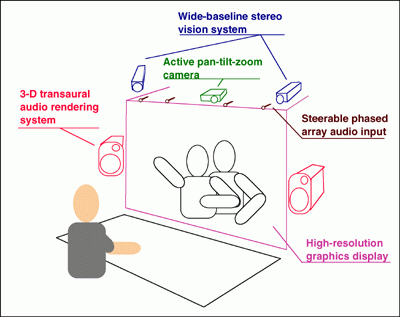SmartDesk Home Page
Introduction

SmartDesk is a project of the Perceptual Computing group at the MIT
Media Lab and encompasses experimentation on a range of computer-based
perceptual input and output systems in a personal work environment.
Hardware
The hardware consists of visual input (wide-baseline stereo,
pan-tilt-zoom camera), visual output (large screen graphics
display), audio input (phased-array microphone), and
audio output (stereo loudspeakers). Other sensor modalities
are also possible.
The wide-baseline stereo is used for visually tracking the macroscopic
movements of the user. The foveating (pan-tilt-zoom) camera is used
to obtain high-resolution images of an area of interest, based on
various attention-focusing algorithms. The phased-array microphone is
used to pick up audio from a direction of interest, usually from the
user's head. And the loudspeakers are used to generate transaural
spatial audio.
Applications
- Planet: visually-guided interaction and transaural rendering
- Puppet: visually-guided animation
- Visually-guided face recognition
*****
Another name for the smart desk is the "Cyberdesk", a term coined by
our research partners at BT (British Telecom).
*****
More online
Movie
Self calibration
3-D person tracking
Face recognition
Facial expression analysis
Gesture, action, and event analysis
American Sign Language
Vision-steered audio input
Transaural audio rendering
References and related research papers
Research reports and publications relevant to the underlying
technologies of SmartDesk applications.
Self calibration
3-D person tracking
-
A. Azarbayejani and A. Pentland, Real-time self-calibrated stereo
person tracking using 3-D shape estimation from blob features,
TR#363, January 1996 (Submitted to ICPR'96)
-
Sumit Basu, Irfan Essa, and Alex Pentland,
Motion Regularization for Model-based Head Tracking
-
Christopher R. Wren, Ali Azarbayejani, Trevor Darrell, Alex Pentland (1995),
Pfinder: Real-Time Tracking of the Human Body
Appears in: SPIE Photonics East 1995, Vol. 2615 pp. 89-98
Face recognition
Facial expression analysis
-
Irfan Essa, Sumit Basu, Trevor Darrell, Alex Pentland (1996),
Modeling, Tracking and Interactive Animation of Faces and Heads using
Input from Video Appears in: Proceedings of Computer Animation '96
Conference, Geneva, Switzerland, June 1996. IEEE Computer Society
Press
-
Irfan Essa and Sandy Pentland (1995),
Coding, Analysis, Interpretation, and Recognition of Facial
Expressions
Gesture, action, and event analysis
American Sign Language
Vision-steered audio input
Transaural audio rendering
Ali Azarbayejani, ali@media.mit.edu
Last modified: Tue Sep 22 11:29:05 EDT 1998

